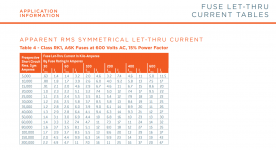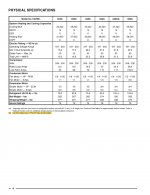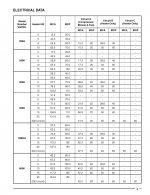You are using an out of date browser. It may not display this or other websites correctly.
You should upgrade or use an alternative browser.
You should upgrade or use an alternative browser.
Fused vs. non-fused disconnect
- Thread starter anbm
- Start date
- Status
- Not open for further replies.
mayanees
Senior Member
- Location
- Westminster, MD
- Occupation
- Electrical Engineer and Master Electrician
Typically, it's when the available fault current exceeds the rating of the switch, which is normally 10kA.
- Location
- New Jersey
- Occupation
- Journeyman Electrician (retired)
Fused disconnects are also used when there are tap conductors ahead of the equipment.
If same circuit serving the equipment is protected by a breaker in panel which has AIC rating > 10KAIC, is fuse still needed for the disconnect? What's the point? Is it code?What mayanees states above (NF disconnects have a 10k AIC rating), and infinsity plus some equipment calls for fuse protection as opposed to breakers
ron
Senior Member
- Location
- New York, 40.7514,-73.9925
The disconnect switch needs to have an adequate short circuit rating as well as the upstream breaker in the panel, so it can withstand a fault if one should occur downstream at the load. If the available fault current calculated at the switch is >5kA, then I typically specify a fused switch, which would have the adequate SCCR.If same circuit serving the equipment is protected by a breaker in panel which has AIC rating > 10KAIC, is fuse still needed for the disconnect? What's the point? Is it code?
mayanees
Senior Member
- Location
- Westminster, MD
- Occupation
- Electrical Engineer and Master Electrician
If the breaker is series-rated or listed with the switch as appropriate for the fault current, then no. But the breaker has to be listed with the switch as being suitable for the available fault current.If same circuit serving the equipment is protected by a breaker in panel which has AIC rating > 10KAIC, is fuse still needed for the disconnect? What's the point? Is it code?
To meet NEC 110.9 or good practice?The disconnect switch needs to have an adequate short circuit rating as well as the upstream breaker in the panel, so it can withstand a fault if one should occur downstream at the load. If the available fault current calculated at the switch is >5kA, then I typically specify a fused switch, which would have the adequate SCCR.
bothTo meet NEC 110.9 or good practice?
(The saving grace being that on small ampere circuits the size and length of the run reduces the SCA to a point the NF switch is acceptable)
Last edited:
Johnhall30
Senior Member
- Location
- -
- Occupation
- -
Fused disconnects are also used to downsize the overcurrent protection for a certain piece of equipment.
For instance you run a 50 amp circuit from a 50 amp breaker to a condensing unit with a 35A MOCP. You can use 35 amp fuses, and meet the requirements of the equipment and have the 50 amp breaker upstream remain.
For instance you run a 50 amp circuit from a 50 amp breaker to a condensing unit with a 35A MOCP. You can use 35 amp fuses, and meet the requirements of the equipment and have the 50 amp breaker upstream remain.
Why not using 35A breaker upstream? 50 breaker and circuit are existing?Fused disconnects are also used to downsize the overcurrent protection for a certain piece of equipment.
For instance you run a 50 amp circuit from a 50 amp breaker to a condensing unit with a 35A MOCP. You can use 35 amp fuses, and meet the requirements of the equipment and have the 50 amp breaker upstream remain.
mtnelect
HVAC & Electrical Contractor
- Location
- Southern California
- Occupation
- Contractor, C10 & C20 - Semi Retired
Look to the manufacture's requirements.
mtnelect
HVAC & Electrical Contractor
- Location
- Southern California
- Occupation
- Contractor, C10 & C20 - Semi Retired
Some of the contractors here use fusible on jobs because:
1. Unlike the unit noted above, some are listed for fuse protection only
2. Often the units nameplate OCP does not match the job prints resulting in the wrong breaker and fuses might be more readily available than a breaker especially in odd sizes.
3. The limited AIC of the NF switch as mentioned earlier.
1. Unlike the unit noted above, some are listed for fuse protection only
2. Often the units nameplate OCP does not match the job prints resulting in the wrong breaker and fuses might be more readily available than a breaker especially in odd sizes.
3. The limited AIC of the NF switch as mentioned earlier.
Strathead
Senior Member
- Location
- Ocala, Florida, USA
- Occupation
- Electrician/Estimator/Project Manager/Superintendent
110.10 in the 2017 code book anyway. The SCCR of the equipment, not the AIC of the breaker.To meet NEC 110.9 or good practice?
I would like to 100% agree with this and expound since some don't seem to grasp. Equipment that isn't marked with an SCCR has to be assumed to be 5KA. I can't cite the code right now, but I remember it to be true. Regardless of series rating as someone mentioned, the available fault current at the piece of equipment is the math resulting from the impedance of the transformer and the resistance of all wiring in between it and the load. If that is greater than 5KA and the SCCR is 5KA then it is a violation of 11.10. The easiest way to correct this is to install fuses, because the inherent nature of fuses reduces the available fault current in almost all cases to an amount less than 5KA. I just received a pretty good education on this myself because in Florida, elevator controllers must now have calculations done and a label placed that stated the available AIC is less than 5000. Since it is 12,000 on the line side of the disconnect, we had to have fuses and calculate the let through of the fuses. Thank you Ron for the platform.The disconnect switch needs to have an adequate short circuit rating as well as the upstream breaker in the panel, so it can withstand a fault if one should occur downstream at the load. If the available fault current calculated at the switch is >5kA, then I typically specify a fused switch, which would have the adequate SCCR.
drktmplr12
Senior Member
- Location
- South Florida
- Occupation
- Electrical Engineer
because you don't know what AHU/CU you are getting and the MCA, until the contractor tells youWhy not using 35A breaker upstream? 50 breaker and circuit are existing?
Grouch
Senior Member
- Location
- New York, NY
are disconnects usually rated 5ka or 10ka? without the fuses.
petersonra
Senior Member
- Location
- Northern illinois
- Occupation
- Semi-retired engineer
Fuses do not change the available short circuit current. They can change the short circuit current rating of a device though. You cannot use the let through current of a fuse in calculating the available short circuit current.110.10 in the 2017 code book anyway. The SCCR of the equipment, not the AIC of the breaker.
I would like to 100% agree with this and expound since some don't seem to grasp. Equipment that isn't marked with an SCCR has to be assumed to be 5KA. I can't cite the code right now, but I remember it to be true. Regardless of series rating as someone mentioned, the available fault current at the piece of equipment is the math resulting from the impedance of the transformer and the resistance of all wiring in between it and the load. If that is greater than 5KA and the SCCR is 5KA then it is a violation of 11.10. The easiest way to correct this is to install fuses, because the inherent nature of fuses reduces the available fault current in almost all cases to an amount less than 5KA. I just received a pretty good education on this myself because in Florida, elevator controllers must now have calculations done and a label placed that stated the available AIC is less than 5000. Since it is 12,000 on the line side of the disconnect, we had to have fuses and calculate the let through of the fuses. Thank you Ron for the platform.
mayanees
Senior Member
- Location
- Westminster, MD
- Occupation
- Electrical Engineer and Master Electrician
I'm gonna disagree with that statement, and I use the following chart as evidence:Fuses do not change the available short circuit current. They can change the short circuit current rating of a device though. You cannot use the let through current of a fuse in calculating the available short circuit current.

I also refer back to 240.86(A) which allows an engineer to permit the use of fuses for existing installations where the fault current exceeds the rating of a breaker. A fuse can be used to permit such an installation provided the fuse operates fast enough to avoid the dynamic impedance of an opening breaker.
ron
Senior Member
- Location
- New York, 40.7514,-73.9925
Speaking mostly for myself, and probably for my 40ish PE colleagues at my firm, we would not sign a document for 240.86(A). This occurs for old equipment (without manufacturer's series ratings) and who knows its long term health.I'm gonna disagree with that statement, and I use the following chart as evidence:
View attachment 2562621
I also refer back to 240.86(A) which allows an engineer to permit the use of fuses for existing installations where the fault current exceeds the rating of a breaker. A fuse can be used to permit such an installation provided the fuse operates fast enough to avoid the dynamic impedance of an opening breaker.
- Status
- Not open for further replies.



